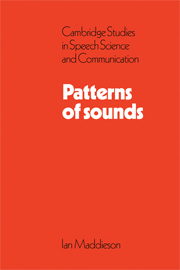Book contents
- Frontmatter
- Contents
- Dedication
- Preface
- 1 The size and structure of phonological inventories
- 2 Stops and affricates
- 3 Fricatives
- 4 Nasals
- 5 Liquids
- 6 Vocoid approximants
- 7 Glottalic and laryngealized consonants
- 8 Vowels
- 9 Insights on vowel spacing
- 10 The design of the UCLA Phonological Segment Inventory Database (UPSID)
- Appendix A Language lists and bibliography of data sources
- Appendix B Phoneme charts and segment index for UPSID languages
7 - Glottalic and laryngealized consonants
Published online by Cambridge University Press: 04 August 2010
- Frontmatter
- Contents
- Dedication
- Preface
- 1 The size and structure of phonological inventories
- 2 Stops and affricates
- 3 Fricatives
- 4 Nasals
- 5 Liquids
- 6 Vocoid approximants
- 7 Glottalic and laryngealized consonants
- 8 Vowels
- 9 Insights on vowel spacing
- 10 The design of the UCLA Phonological Segment Inventory Database (UPSID)
- Appendix A Language lists and bibliography of data sources
- Appendix B Phoneme charts and segment index for UPSID languages
Summary
Introduction
This chapter presents the results of a survey of the occurrence of glottalic consonants and other “glottalized” consonant segments in our sample of the world's languages, and relates their occurrence to the rest of the segments in the phonological inventories of the languages. It draws substantially on a previous survey of the same data by Fordyce (1980).
In an important earlier study, Greenberg (1970) discussed the distribution of glottalic consonants cross-linguistically and language-internally. Although there has been considerable subsequent work addressing Greenberg's claims, much of it either suggests specific counter-examples (e.g. Campbell 1973; Pinkerton 1980) or brings little additional data to bear on the general validity of his conclusions (e.g. Hamp 1970; Javkin 1977). Greenberg's main claims are summarized in the sentence “injectives [i.e. implosives] tend to have front articulation, ejectives to have back articulation”. Greenberg acknowledges that these conclusions were partly anticipated by Haudricourt (1950) and independently discovered by Wang (1968).
Our goal is to determine whether these place of articulation preference hierarchies for implosives and ejectives can be substantiated and to discover other distributional patterns relating to glottalic and glottalized segments in the UPSID data. The possible phonetic motivations for the patterns found will also be discussed. Greenberg's generalizations were based on a survey of languages for which data was available rather than on a carefully structured sample and it is possible that his findings reflect accidental biases in the selection of languages examined.
- Type
- Chapter
- Information
- Patterns of Sounds , pp. 98 - 122Publisher: Cambridge University PressPrint publication year: 1984

